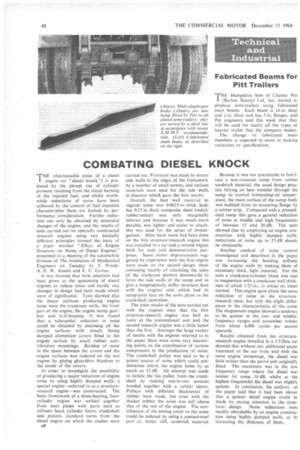COMBATING DIESEL KNOCK
Page 42

If you've noticed an error in this article please click here to report it so we can fix it.
THE objectionable noise of a diesel engine for " diesel knock') is produced by the abrupt rise of cylinder pressure resulting from the initial burning of the injected fuel, arid whilst worthwhile reductions of noise have been achieved by the control of fuel injection characteristics these are limited by performance consideration. Further reduction can only be obtained by structural changes of the engine, and the results of tests carried out on specially constructed research engines using two basically different principles formed the basis of a paper entitled "Effect of Engine Structure on Noise of Diesel Engines" presented to a meeting of the automobile division of The Institution of Mechanical Engineers on Tuesday by T. Priede, A. E. W. Austen and E. C. Grover.
It was stressed that little attention had been given to the quietening of diesel engines to reduce noise and hardly any changes in design had been made which were of significance. Tests showed that the major surfaces producing engine noise were the crankcase walls, the front part of the engine, the engine sump. gearbox and bz,11-housing. It was found that a substantial reduction in noise could be obtained by enclosing all the engine surfaces with closely fitting damped aluminium covers fitted. to the engine surface by small rubber antivibration mountings. Buildup of noise in the space between the covers and the engine surfaces was reduced on the test engine by. gluing glass-fibre blankets to the inside of the covers.
In order to investigate the possibility of producing a major reduction of engine noise by using highly damped walls, a special engine—referred to as a structureresearch engine—was constructed. The basic framework of a three-bearing, fourcylinder engine was welded together from steel plates with parts such as cylinder head, cylinder liners, crankshaft and pistons, standard. items from the diesel engine on which the studies were Its carried out. Provision was made to secure side walls to the edges of the framework by a number of small screws, and various materials were used for the side walls to discover which gave the best results.
Overall, the best wail material as regards noise was 0.0625-in.-thick lead, but 0.25 in, thick composite sheet (metal/ rubber/metal) was only marginally inferior and because it was much more durable, was lighter and easier to attach, this was used for the series of investigations. After basic work had been done on the firSt structure-research engine this was installed in a car and a second engine built for tests and demonstration purposes. Some minor improvements suggested by experience with the first engine were made on the second design, these consisting mainly of extending the sides of the crankcase portion downwards to form the side walls of the sump and so give a longitudinally stiffer structure than with the original unit, which had its sump-joint face on the same plane as the crankshaft centreline,
The main results of the tests carried out with the engines were that the first structure-research engine was half as noisy as the conventional unit and the second research engine was a little better than the first. Amongst the large variety of results with the engines referred to in the paper there were some very interesting points on the contribution of various components in the production of noise. The crankshaft pulley was said to be a potent source of noise which could predominate above the engine noise by as much as 15 dB. An attempt was made to isolate the fan pulley from the crankshaft by making one-in-two sections bonded together with a rubber sleeve. Pulleys with different thicknesses of rubber were made, but even with the .thicker rubber the noise was still above that of the rest of the engine. The contribution of the timing cover to the noise could be reduced by using a pressed-steel part or. better still, sandwich material. Because it was not practicable to fabricate a non-resonant sump from rubbei sandwich material, the usual design prac. rice relying on heat transfer through the sump to control lubricating-oil temperature, the main surface of the sump body was isolated from its mounting flange by a rubber strip. Compared with a pressedsteel sump this gave a general reduction of noise at middle and high frequencies of between 15 and 20 dB. The tests showed that by employing an engine construction with highly damped walls reductions of noise up to 25 dB shoule be obtainable.
Another method of noise control investigated and described in the papet was increasing the bending stiffnes; of the engine walls by making them of extremely thick, light material. For the tests a crankcaselcylinder block was cas1 in magnesium with a crankcase wall thickness of about 1-25 in., or about six times normal. This engine gave about the same reduction of noise as the structureresearch units, but with the slight differ ences in the characteristics of the noise The magnesium engine showed a tendency to be quieter in the lowand middle. frequency ranges and somewhat noisiet from about 4,000 cycles per second upwards.
Results obtained from the structureresearch engine installed in a I.5-fitre cat showed that without any additional sounc treatment to the car body and with the same engine mountings, the diesel wa; little noisier than the petrol unit originally fitted. The maximum was in the lovl frequency range where the diesel wal noisier by some 10 dB, whilst at the highest frequencies the diesel was slightly quieter. In conclusion, the authors ol the paper said that it had been showr that a quieter diesel engine could be made by paying attention to the struc. tural design. Noise reductions wen readily obtainable by an engine construe ticrn using highly damped walls, or bl increasing the thickness of them.
















































































































